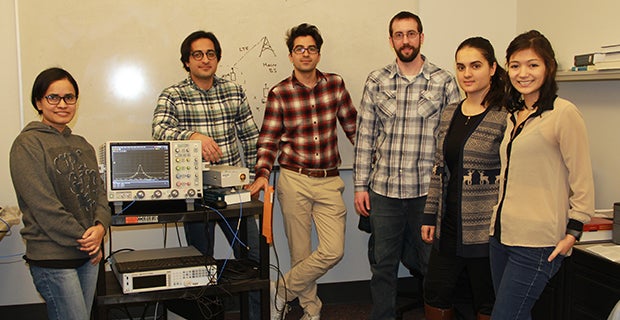
Boise State’s second annual Research Month is April 2018. Research Month celebrates the diverse and fascinating array of research happening each day on campus.
Hani Mehrpouyan, an assistant professor in the Department of Electrical and Computer Engineering at Boise State, has assembled a diverse team of ambitious doctoral student researchers from top universities in Iran, Pakistan and Bangladesh, all working on a common goal: creating sophisticated signal processing and antenna designs for next generation wireless networks, specifically for the advancement of millimeter-wave communications.
Why is millimeter wave technology important?
All electronic devices in our homes use specific radio frequency spectrum to interconnect with one another, however, most are restricted to frequencies up to 6 gigahertz (GHz). But thanks to our explosive use of electronics, this range currently is congested, which is why researchers are turning their attention to developing standards over 28 GHz – otherwise known as millimeter wave frequencies (mmWave), which encompasses the band of spectrum between 28 GHz and 300 GHz.
Ahmed Kausar was the first graduate student to join Mehrpouyan’s research team in the fall of 2015. Since then, Kausar has authored and co-authored 11 Institute of Electrical and Electronics Engineers (IEEE) research papers, while also designing a new class of smart antennas that can be used to overcome channel propagation issues at mmWave frequencies. This work led to Kausar’s successful patent application, Reconfigurable Antennas for Millimeter-wave Systems that Support Multiple Beams, which has been approved by the United States Patent and Trademark Office.
Roohollah Amiri joined Mehrpouyan’s group in the spring of 2016 after having graduated first in his class from Iran University of Science and Technology in Tehran. Roohollah’s research interest is focused on wireless communication with an emphasis on resource allocation. He has been working on using machine learning to manage resources in the next generation of dense wireless networks. His work, which will be published in IEEE International Conference on Communications, shows that machine learning can significantly reduce the overhead associated with managing the resources in a wireless network and achieve much higher overall throughputs.
Mojtaba Ahmadi, another alumnus of Iran University of Science and Technology, joined Boise State in the fall of 2016 after graduating third in his class. Ahmadi recently has been working on the design of new signal processing algorithms intended for use with Kausar’s new class of smart antennas. Ahmadi also has been quite active publishing his works through IEEE conferences and journals. In fact, an article he co-authored with advisor Hani Mehrpouyan, Vida Vakilian, Nader Behdad and Hamid Jafarkhani titled “A New Reconfigurable Antenna MIMO Architecture for mmWave Communication” recently was accepted by the IEEE International Conference on Communications, one of the most prestigious conferences in communications.
This spring, two new members joined Mehrpouyan’s graduate research team. Mahfuza Khatun served as a lecturer in electrical and computer engineering at Dhaka International University in Bangladesh prior to coming to Boise in 2015. After completing her master’s in electrical engineering at Boise State in 2017, she is signing on as a doctoral student in Mehrpouyan’s research team.
Saideh Shad is the newest member of the research team. Her master’s research focused on the design of a new dielectric resonator antenna prototype for WLAN applications. After graduating, Shad worked in various capacities at the Iran University of Science and Technology and Khajeh Nasir Toosi University of Technology, before committing to Boise State for further study at the doctoral level.
Mehrpouyan is excited to see his team grow and says he is looking forward to seeing what new advances are on the horizon. Learn more about Mehrpouyan’s research group online at http://www.mehrpouyan.info.